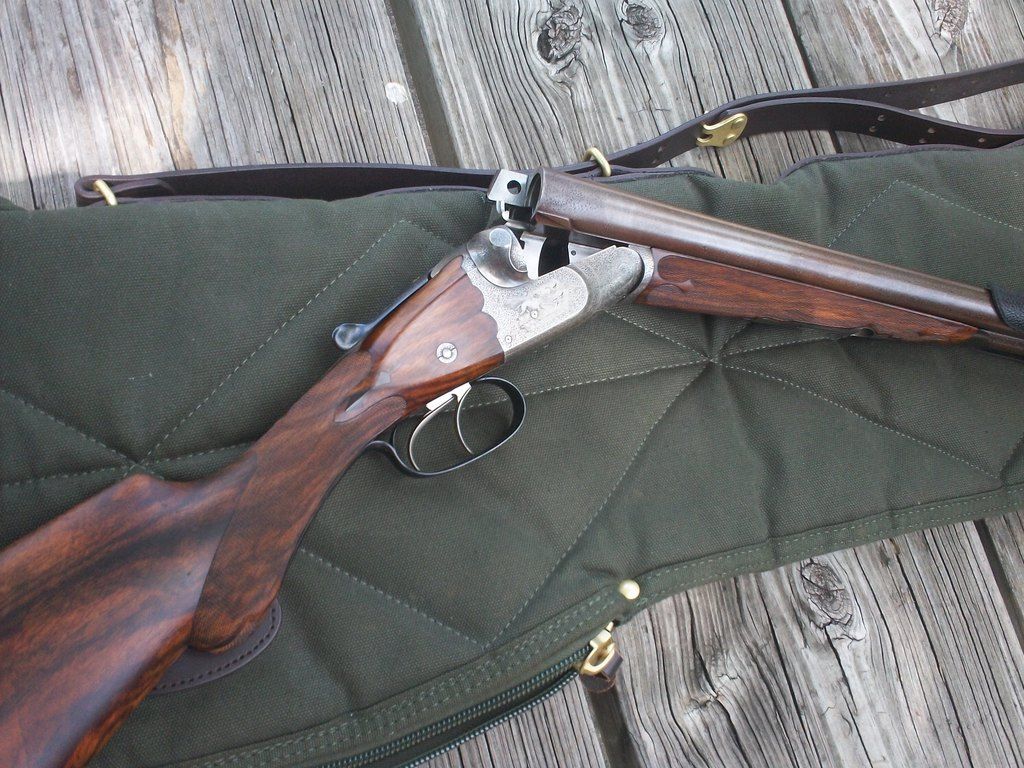"Woody402," I am glad you asked, because I have long wished to participate in a side-by-side event but, together with competing office scheduling conflicts, could not decide what gun(s) would be appropriate to take to such an event. The correspondence here helpfully defines what most would use in such circumstances. In the main, like the majority of gun owners, I suspect, I employ my guns afield and only get to the local gun club or attend events infrequently. When I do go, I bring along a wide variety of bore-size guns, from 20-bore to 10-bore, hammerless and hammer-guns, all of which are damascus-barreled side-by-sides, and which seem more likely to evoke looks of surprise, curiosity and envy from the other club shooters. I greatly enjoy answering their questions, showing and extemporizing on my antique guns, and will sometimes allow them a shot or two at the clay targets, in order to hopefully peak their interest and bring them into the fold, as it were. Every serious gun enthusiast should have a side-by-side gun, as long as it does not affect the prices I pay for the antique guns of interest to me; achieving this is a sort of long-term personal project.
The two 12-bore guns I might choose to employ at side-by-side events, however, are a 2-1/2 inch chambered
W. W. Greener facile princeps G 60 Crown Grade, self-acting ejector gun (choked 1/4 and barely 1/2) and a (my 2nd 'original') 3-inch chambered (Although in which, of course, I use appropriate 2-1/2 inch cartridges instead.) Prussian
Charles Daly 250 Grade ejector gun (choked full and full or .036). Both have 30-inch barrels and weigh 7 and 7-1/2 pounds, as well as possess drops-at-heel of 2-1/2 and 3-inch, respectively. Each has a length-of-pull of 14-3/4 inches. For me, all things being otherwise normal, the length-of-pull is the most critical butt-stock measurement, as a LOP of 14-1/4 or even that of 14-1/2 inches hammers and rattles me.
On the other hand, deep drops at heel do not bother me or my success when shooting in the slightest. For example, I have a pristine 12-bore Prussian
Charles Daly 200 Grade (Diamond Quality), choked cylinder and improved cylinder, with a drop-at-heel of 4-1/8 inches that is an astonishing quail gun (Charles Askins said it worked and he is right.). It has the bend of a Kentucky Long Rifle seen fitted in its full length shotgun case.
Below is the circa 1893 W. W. Greener gun (all wood restored and some metal work by Paul Hodgins, and all metal preparation and barrel work by Kirk Merrington) referred to above, after its use on the San Antonio Gun Club trap range two weeks ago. Remark the hand-guard, doubly needed due to a string of 100 rounds fired at clay targets and the unremitting influence of the day's 100+-degrees heat index.

The original condition Prussian
Charles Daly (serial no. 326, circa 1888-91) 250 Grade ejector gun below also had a run of another 100 targets same day and required a hand-guard too, which is seen still attached. Its over-tight chokes will be reduced to 1/4 and 1/2 choke, my preferred constrictions, in the very near future. As with all my antique 12-bores, I use nothing more than an ounce of shot, and 3/4 of an ounce (of shot size nos. 7, 8 or 9, depending on use), in my opinion, would be markedly better, coupled with low dram equivalence, and tend to the
RST or
Polywad brand low pressure loads, to spare old and irreplaceable wood and barrels unnecessary jolts.

If I chose to participate additionally in the 20-bore or the 10-bore events, I would employ my 'Best' and 'Highest Quality'
Westley Richards hammerless boxlocks, both rib-extension single-bite locking system guns circa 1882, each having lengths-of-pull approximating 14-3/4 inches. Of the two, the 20-bore is my favorite, with its Skeet nos. 1 and 2 chokes, as it is not too light (having been built on an intended 16-bore frame and set of barrels), yet is fast swinging and particularly deadly, even with its 28-inch barrels. The 10-bore gun, with both barrels choked improved modified, crushes everything in the path of whatever size or amount of shot (usually 1-1/8 ounces) is sensibly launched from its 30-inch Oxford pattern damascus barrels, and as a bonus, being of the 'Highest Quality,' it is a practical work of art.
I would very much like to report that I am a crack-shot and never miss but little, which if claimed would be at least a fable on my part. But there is something to be said about our antique or vintage side-by-side guns, which have been carefully maintained and stored wherever in your house and finally taken afield or after a drive with you to the range or club, when you hear the piece go boom(!), and enjoying that anticipated moment you actually hit the target though you had not thought you would. What I like about joining in the subject events is the opportunity to share with fortunate others that just described sense, when multiplied by separate experiences, which only those having a shared interest can enjoy. The pleasurable exchange of information amongst the attendees and hours spent looking at exemplars of the fine side-by-side brought to the event by their respective owners also would be of great interest.
Unfortunately, for me and perhaps for others living in the near equitorial Southwest U.S., there are no such regional events for side-by-side owners and practicing aficionados to attend, unless I am much mistaken. And I do not care much for traveling with or shipping a valuable gun or guns very far from home these days. Would that this situation will change.
Regards,
Edwardian